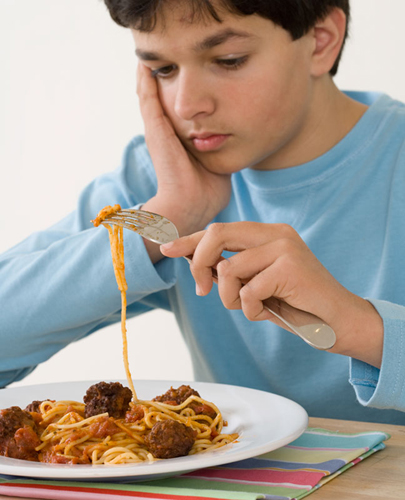Anorexia and bulimia
Anorexia nervosa and bulimia nervosa are the two main categories of eating disorder.
There are many similarities between the two groups: As many as 40
percent of sufferers of anorexia engage in binge eating. However most
binge eaters do not go on to develop anorexia. The neat differentiation
between different types of eating disorder is more imposed than real,
and current advances in psychotherapeutic treatment tend to cross the
diagnostic categories.
The key characteristics of
anorexia are a morbid fear of being fat, significant weight loss (BMI of
under 18), perceived distortions of body weight and shape, and
cessation of periods. Bulimia is characterized by normal or above
average weight, binge eating, regular vomiting or laxative abuse, loss
of control over eating, and worries about body shape and weight.
A UK study of 13 to
19-year-old females found that there was an incidence of 50 cases of
anorexia per 100,000. Bulimia is thought to affect 0.5 percent to 1.0
percent of young women.
Why do eating disorders develop? A combination of many factors
Our teenagers are
exposed to the Western societal anxiety about healthy eating, body
weight, and exercise. Our daughters read magazines and watch television
shows and movies that promote thinness as desirable and attractive. They
therefore grow up with an ideal of female beauty that is unrealistic
and unachievable. An average teenage girl would need to be two and a
half inches (5 cm) taller, increase her bust size by five inches (12.5
cm), and decrease her waist by six inches (15 cm) in order to resemble
Barbie! Boys are also coming under increasing pressure to conform to
movie-star ideals.
Different pressures
There are a considerable
number of factors involved in the development of an eating disorder.
These are characteristics of the individual young person, features of
her family, and socio-cultural pressures. They combine in complex ways,
initially to make a young person more vulnerable to developing an eating
disorder, then to tip her from just having difficulties around eating
into what would be recognized as a clinical and, sometimes, life
threatening, condition and finally, to establish and maintain the
disorder as part of her life. This makes it hard to definitely say what
causes the disorder and what is a consequence of the disorder.
Each of these factors on
its own is not enough to be dangerous, and in many cases, can be seen as
normal adolescent issues. It is the complex interactions that lead to
the worrying results.
How all these factors
combine is not yet known. Some think that the normal stress of
adolescent transitions—puberty, identity formation, sexual development,
academic demands—and overvaluation of thinness in a young person who
lacks a solid family base and strong sense of self, all combine to
produce disordered eating of enough severity to constitute a clinical
illness.
Genetic causes
A girl may have
inherited a vulnerability that predisposes her to eating problems. If a
close relative has had eating difficulties, she has a higher risk of
developing a disorder, but it doesn’t mean that she definitely will.
Body image
Eating disorders
often develop around puberty, when a girl will typically experience an
increase in body fat. This can lead her to perceive that she is fat. She
may start to diet and exercise and experience a dip in her self-esteem.
Having a distorted body image, particularly thinking she is fatter than
she is (and feeling unhappy about how she looks), is a key factor in
the development of a disorder, but on its own is not sufficient.
Underpinning this state of affairs is her belief that appearance is
vital to her self-image and the approval and acceptance of others.
Dieting and exercise
She may try to diet to
change her body weight and shape. Typically this is not successful, and
may lead to her feeling depressed about her inability to change herself
and feel good about herself. Dieting is pretty normal in adolescent
girls, but it is particularly common among girls with a distorted body
image. Dieting also leads to binge eating which can be the beginning of a
vicious cycle of bingeing and dieting or purging. She may try using
strenuous exercise to alter her body weight and shape, and in a
vulnerable girl this may become obsessive in time.
Family interactions
All of
these individual characteristics combine with particular family
interaction patterns and parental influences to further increase the
risk of an eating disorder developing. Her mother may have had an eating
disorder herself or at least have had some of the characteristics. She
may learn about dieting and extreme weight-loss measures from emulating
her mother. She may have experienced critical comments from her parents
about her weight or appearance. She is more likely to have a family that
does not feel secure. They may not communicate very effectively with
their adolescent daughter and may have a variety of other family
difficulties, such as having lots of negative emotion being expressed
without reaching comfortable resolutions. This young woman will be
driven to please others more than achieve a set of her own goals. She is
struggling to develop her own identity. She will not feel she has or is
able to achieve autonomy from her parents, who show ambivalence about
relinquishing control to their developing daughter. She will respond to
their mixed messages of overprotection, over-control, and under-concern
with her own version of self-control: Extreme control over her eating.
Cultural influences
Western society has
produced the myth of the superwoman: Someone who is physically
attractive and successful in her career, as well as being a good partner
and mother. These enormous and conflicting demands place extra stress
on an adolescent who wants to achieve perfection, who is struggling with
her identity, who overvalues the views of others, and who has not had
an easy nurturing experience. Her response to this stress is to apply
more pressure to be perfect and to apply more control to the thing she
can control, her body.
Media influences
Reading magazines that promote thinness and focus on body image may be one of the factors involved in eating disorders.

Thinner
Although dieting is common in teenage girls, it can become obsessive.

“Manorexia”
Boys are also vulnerable to eating disorders, for much the same reasons as girls.

Irritable
Lack of food, or dieting and bingeing, can affect emotions, leading to mood swings and irritability.
